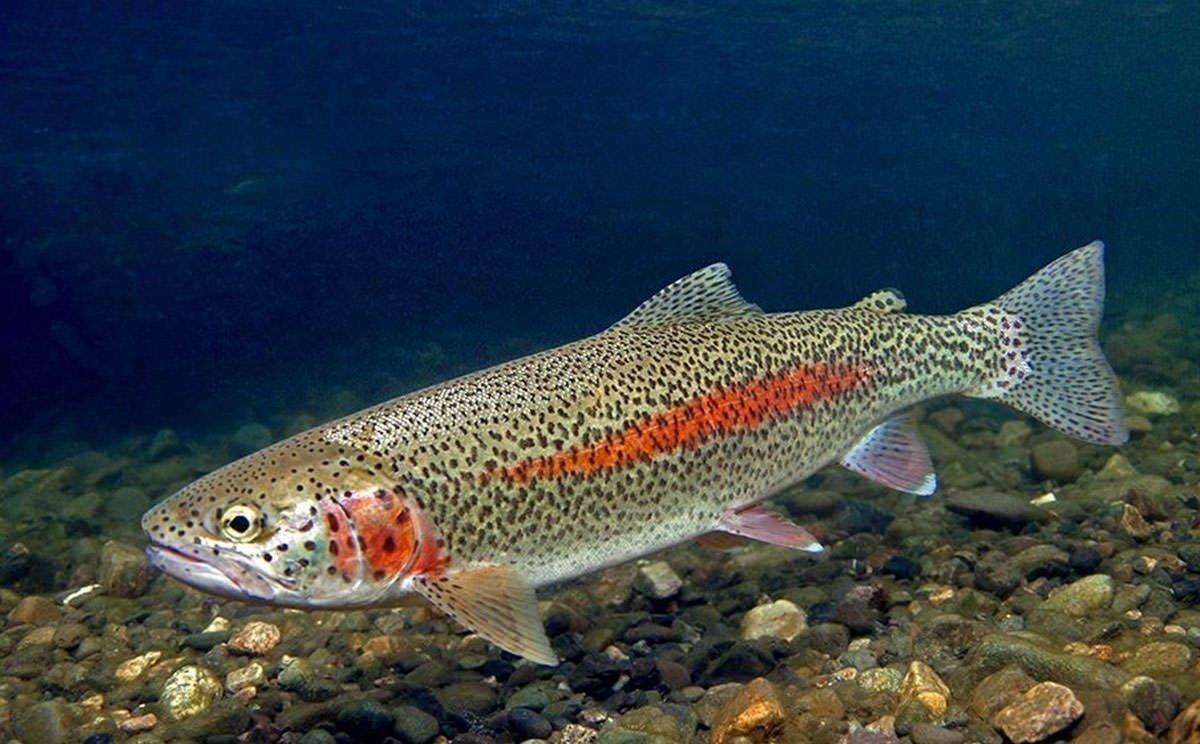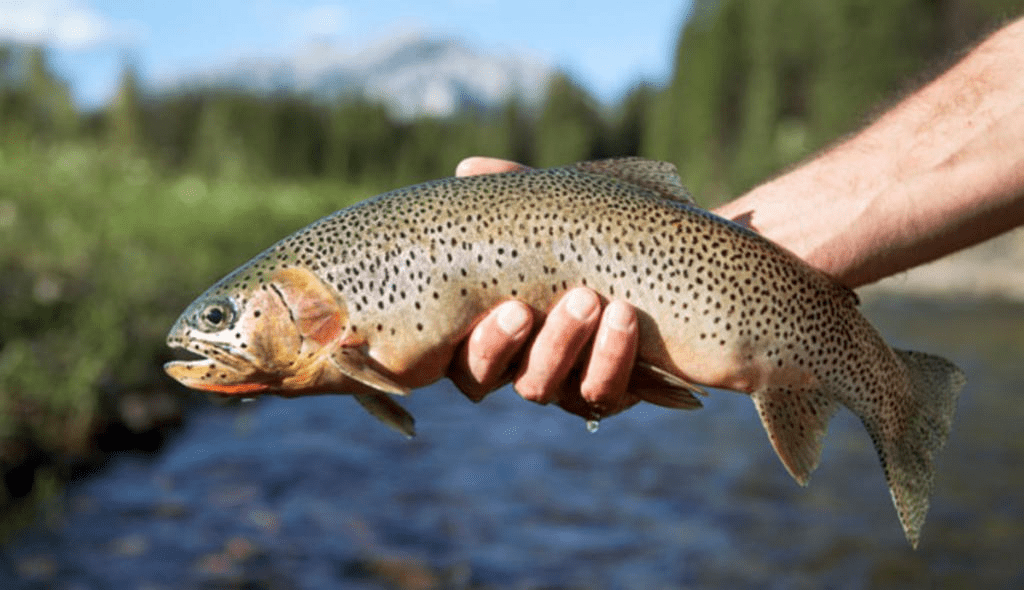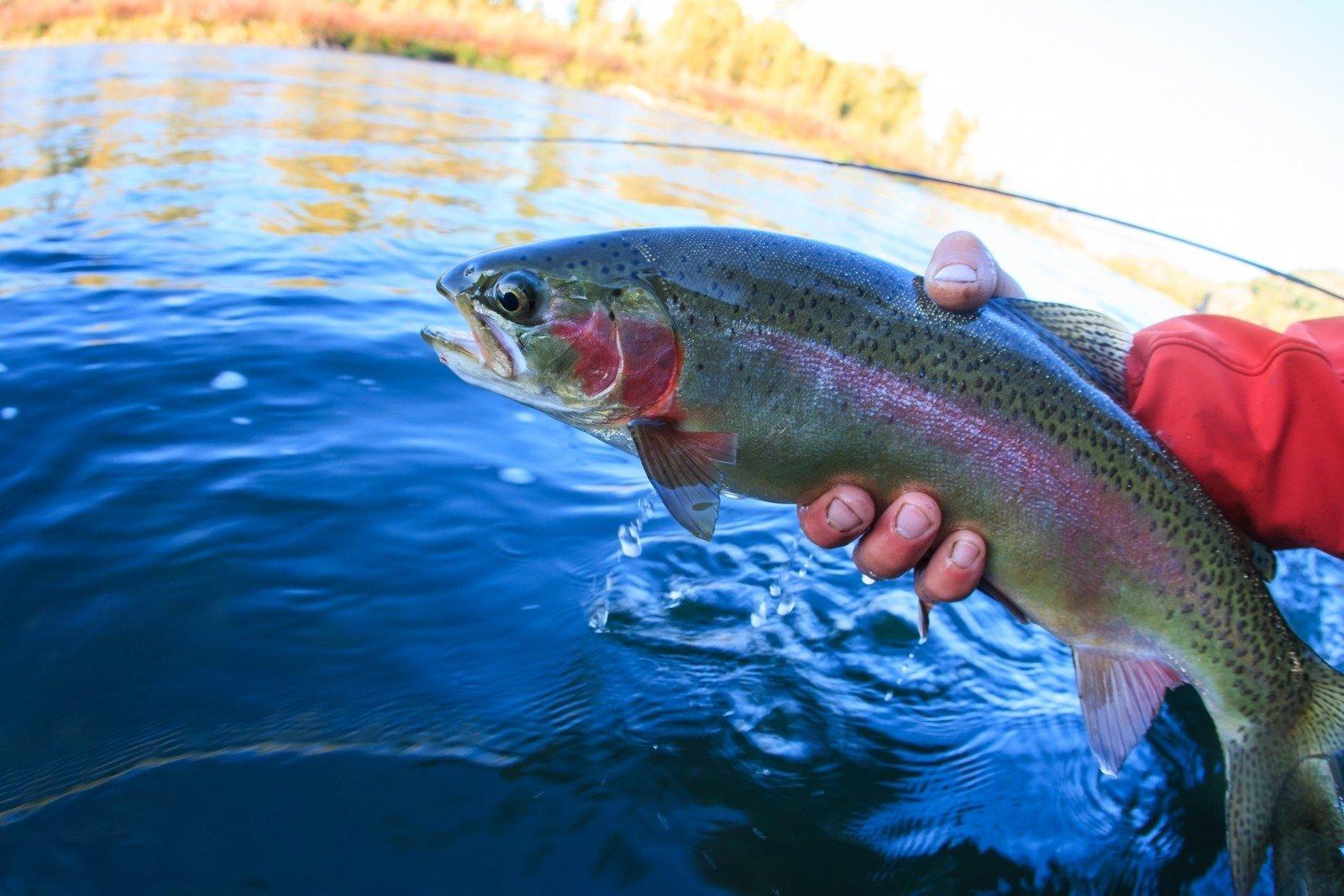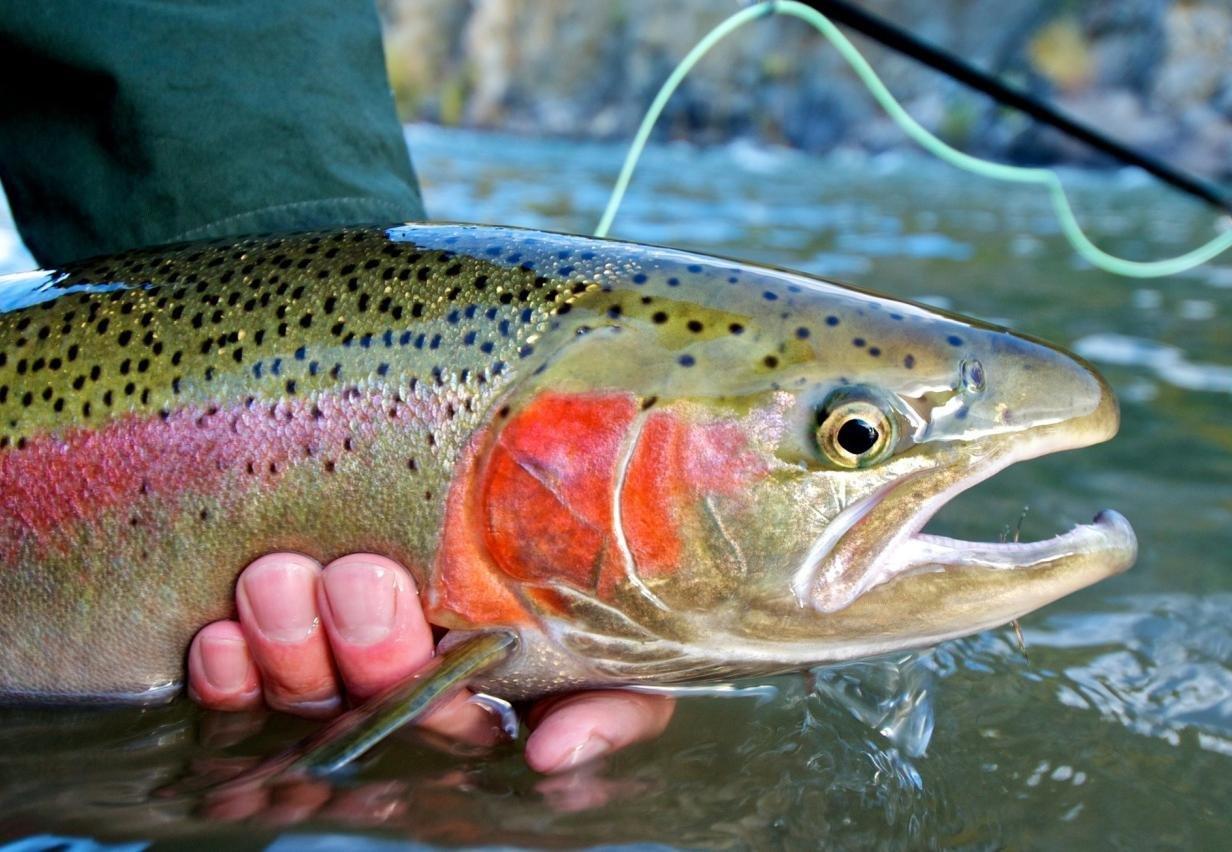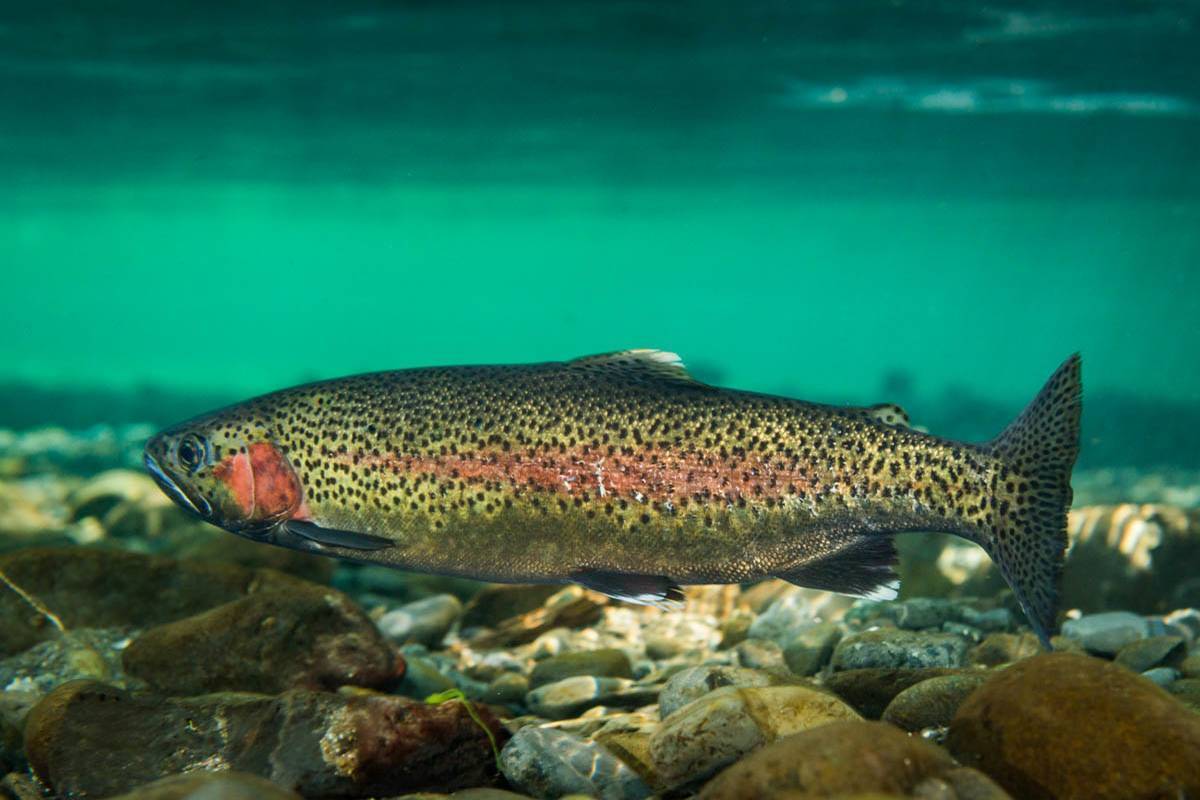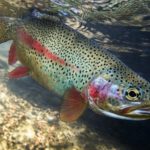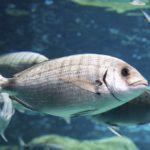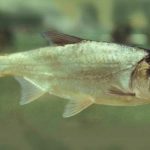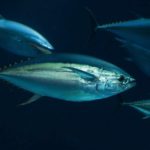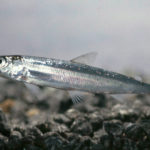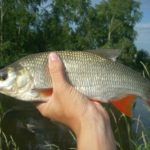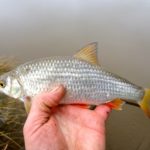Trout is a general term for many species of salmonid fish, such as Atlantic and Pacific salmon and char. This red fish is highly sought after by sport anglers and all fishing enthusiasts due to its rarity and selective habitats, which make it difficult to catch, as well as its delicious taste, which makes it a valuable commercial species.
What does trout look like?
These river fish come in different species, each with its own distinctive characteristics and found in different natural habitats. Several species of trout fish can be found in Russia, including lake, rainbow and brook trout.
Physical characteristics of the fish include:
- strong build with flattened sides;
- a short snout crowned with numerous teeth (females have fewer);
- small eyes;
- larger size of females compared to males;
- trout can have different colors depending on the subspecies and habitat, but usually they are greenish-gray or bluish-gray above and silver or white below;
- light transverse stripes and dark spots on the body (in particular, a pink stripe along the abdomen in the rainbow variety);
- her body is covered with small scales that have a metallic sheen;
- on the lateral line, which stretches along the body, small dark dots are visible;
- very often trout have a reddish tint in the area of the gill covers and belly.
The color of a fish can be determined based on the environment in which it lives. Individuals living in peat-bottomed waters tend to be brown, while those living in calcified waters have a silvery back. If food is scarce, trout may lose their stripes and spots due to lack of nutrition.
The size of the fish varies depending on the type of body of water in which it lives; Sea trout tend to be larger than those found in fresh water. Typically, most individuals measure up to 28-32 cm in length and weigh between 230-550 grams.
This fish can be much larger than average. The largest individual can weigh up to 2.3-5.5 kg and measure more than 0.6 m in length.Moreover, there are some huge brook trout that reach 46 cm and even 13 kg in weight when they are 10-13 years old. The rainbow variety can even exceed six kilograms in weight.
The official record for the largest trout caught is a fish weighing 6.3 kg, which was discovered in Estonia. Even larger specimens have been unofficially reported; the largest lake trout were rumored to weigh up to 16 kg, and there were reports of individuals from Baltic rivers weighing up to twenty kilograms. However, these are not officially confirmed cases.
The color of trout meat can vary from bright red, milky cream, white, pinkish, yellowish or red-orange. The flesh of most freshwater fish is usually white or slightly pink, while sea trout is usually bright red. All types have a soft and creamy fillet texture with a characteristic layer of fat that adds flavor.
Sometimes it is confused with salmon, but there are a number of criteria by which trout can be accurately identified:
- Firstly, it lives in rivers, lakes and freshwater reservoirs, while salmon is found in sea waters and rivers flowing into the sea.
- Secondly, it has a brighter color than salmon, with a red or pink tint on the ventral side and darker spots on the back.
- Thirdly, it has a softer and more delicate meat consistency, while salmon meat is denser and fattier.
- Finally, it is often farmed in ponds and aquaculture, while salmon is wild caught or raised in marine aquaculture.
Description of lifestyle
Trout is a freshwater fish that lives in fast mountain rivers and lakes. The lifestyle of trout can vary depending on habitat conditions and the age of the fish.
Young trout live in fast-moving streams and rivers, where they feed on insects and small invertebrates. Adults live in slower currents, lakes and ponds, where they can feed on larger fish, shrimp and crustaceans.
Trout are active during the day and night, but prefer active activity in the dark. Fish can travel considerable distances in search of food and convenient places to rest.
During the winter season, when the water cools, trout become less active, hibernate or move to warmer areas of the reservoir. In spring, when the water temperature rises, the fish begin to actively feed and reproduce.
Trout is a predatory fish and feeds mainly on small fish, aquatic insects and their larvae, crustaceans, as well as various algae and vegetation. A trout's diet can vary depending on its age, habitat, and environmental conditions. In natural conditions, trout actively catch prey using their quick reflexes and keen vision. Adult trout very readily eat their own offspring.
Trout eggs are already at risk before they even have a chance to mature. Not only is this a tasty snack for other fish, but the trout themselves will also try to snack on them. Of all young trout, only 10% survive their first year, and half of them do not survive subsequent years. Adult trout are often hunted by bears and seals, birds of prey, and many are caught by humans for food. On average, only 2.3% of these fish survive to the point where they can reproduce.
Trout is a large family of fish that includes various species such as salmon, Pacific salmon and char.White trout have pale or light pink flesh and are found in Norway and the United States, while the farmed amber trout have bright orange scales. Trout species can be distinguished based on geography (Karelian, Norwegian) and habitat (mountain, sea, lake, river or pond).
The nutritional value
The flesh of salmon-type fish is soft and creamy, with a yellowish or pinkish tint, which depends on the places where the fish lived. The fillet contains a thin layer of fat, which gives off an aromatic odor. Trout can be prepared in many ways, such as frying, smoking, boiling, marinating, braising, steaming or baking. It can also be dried and consumed as an accompaniment to alcoholic drinks.
Deli meats are often cooked whole or stuffed with nuts and fruits. Many rich soups and first courses are prepared from this type of fish; In addition, it is used raw to prepare sashimi dishes, as well as delicacies such as tartare or Japanese sushi.
100 grams of trout fish meat contains many useful substances, including:
- Protein: about 20 grams.
- Fat: About 7 grams, including monounsaturated and polyunsaturated fatty acids.
- Vitamin B12: 154% of the recommended daily value.
- Vitamin A: 9% of the recommended daily value.
- Vitamin D: 127% of the recommended daily value.
- Vitamin E: 3% RDA.
- Iron: 3% RDA.
- Phosphorus: 16% RDA.
- Potassium: 6% of the recommended daily value.
Trout fish is also rich in antioxidants and Omega-3 fatty acids, which have a beneficial effect on heart and vascular health, improve brain activity and the immune system.
The energy value of trout varies depending on how it is prepared.One hundred grams of boiled king fish contains 90 kilocalories, smoked - 129, canned - 163, lightly salted - 187 and fried - 220.
Advantages
Sea trout meat has several health benefits:
- Rich source of healthy proteins needed to maintain healthy muscles and tissues.
- Contains essential fatty acids such as omega-3, which help lower blood cholesterol and improve heart and vascular function.
- It is a source of B-complex vitamins necessary for the normal functioning of the nervous system and energy production in the body.
- Rich in minerals including calcium, iron, phosphorus and selenium. They are essential for maintaining healthy bones, teeth, muscles and the immune system.
- In addition, trout fish meat has a pleasant taste and can be used in various dishes, making it a popular product in the kitchen.
Doctors advise people with depression, osteoporosis, psoriasis, allergies, diabetes or heart disease to regularly consume trout fillet. Boiling fish makes it low in calories, making it an ideal food for those looking to shed a few pounds.
The compounds contained in red fish have a healing effect on the human body. Among the reasons why you should definitely include this fish in your diet are:
- Helps eliminate excess cholesterol and regulates blood sugar levels, stomach acid production and water metabolism.
- Increases blood circulation, supports heart health, breaks down fats, helps in the metabolism of amino acids and hormones, and metabolizes energy.
- Prevents or reduces the risk of myocardial infarction (heart attack).
- Increases mental activity.
- Strengthens the immune system, as well as the nervous and cardiovascular systems.
- Slows down the aging process of the body, fighting free radicals that can lead to the formation of malignant tumors.
In addition, trout fillet promotes better absorption of iron, which leads to improved skin and hair condition, as well as strengthened tooth enamel. The beneficial substances contained in it break down carcinogens, reducing stress levels and having a restorative effect on overall well-being. Finally, it has a beneficial effect on reproductive function by lowering blood pressure levels.
Flaws
Mountain and river trout are considered non-allergenic, so they do not cause serious harm to individuals. However, these fish may contain mercury, which is extremely harmful for pregnant and lactating women, as it pollutes the baby's body and can even lead to miscarriage.
Trout can be found both in their native habitat and in fish farms, where owners use synthetic additives to make the fish grow faster and give the flesh a more attractive color. Those with allergies should be careful when consuming such fish, as artificial colors may cause a reaction.
Fish should not be consumed if a person has any diseases of the liver, kidneys or digestive organs in acute or chronic form. And also if there is intolerance to it.In addition, due to its low calorie content, it should not be consumed by those who engage in strenuous physical activity, as well as athletes, otherwise it may lead to loss of strength, loss of vitality and lack of strength. To prevent fatigue, those who eat trout should eat it in combination with vegetables, grains or legumes.
How to catch trout
The sport fisherman is most attracted to the following types of trout: brook, sea and lake. These fish usually remain in one place almost their entire lives, although they can move in search of spawning sites (rivers). Trout lay eggs when the weather turns cold, with temperatures ranging from 1-6 degrees Celsius (October to February).
Trout can be caught all year round, although luring and catching them requires considerable stamina and experience. In winter, her alertness increases. Despite the fact that at this time the fish are in a sluggish state, they still quickly react to any sound or action of the fisherman. Sensing a threat, they will quickly retreat into the depths of the lake and remain at the bottom. To effectively catch trout, anglers need to fish near fresh holes, as they cannot be found near old ones.
As the snow melts and ice-free areas appear, fish activity increases. In the spring, the fish remain in their “wintering pits” or migrate to rivers where oxygen is more available. During the summer months it is rarely found near coastlines.
Ideal places for trout fishing include streams with tributaries whose water temperature does not exceed 18 degrees Celsius. On hot days they usually come out at night when the water cools.
Spawning begins again in the fall, and during this time they are constantly active, feeding in such a way as to increase their weight. At this stage, various baits work well, such as tadpoles, spinning rods, wobblers and juvenile fish. However, trout's favorite baits are larvae, fish eggs, crustaceans, and insects.
How to breed fish
For the food industry and industrial purposes, trout are bred in fish farms, for example, lake or rainbow varieties. It takes a year and a half to raise each individual to a weight of 0.5 kg, with large specimens being retained as mother stock for the production of red caviar, which is salted for sale. It not only looks great, but is also considered a valuable product that can improve the health of the person who regularly uses it.
The fish reaches sexual maturity after four years, and one female can produce up to three thousand eggs, which makes this product a very popular delicacy.
Recommendations for salting
The classic recipe for pickling wild trout is quite simple and includes only a few ingredients. Here's how to cook it.
Ingredients:
- trout (preferably fresh);
- coarse salt;
- sugar;
- black peppercorns;
- Bay leaf;
- water.
Steps:
- Clean the trout from scales, remove the head and entrails, leaving only the meat and tail.
- Prepare the brine by mixing coarse salt, sugar and black pepper with water in a 1:1:1 ratio. Add bay leaf to the brine and stir.
- Place the trout in a glass or ceramic container and fill with brine until it completely covers the fish.
- Cover the container with a lid or film and refrigerate for 24-48 hours (depending on the thickness of the fish and the desired degree of salting).
- After salting, remove the fish from the brine, rinse with cold water, dry on paper towels and cut into pieces or portions.
Salted trout is ready to eat and served as an appetizer, or used as an ingredient in various dishes.
Good recipes
A simple recipe for trout fish baked with vegetables.
Ingredients:
- 2 trout.
- 2 potatoes.
- 1 large onion.
- 1 large tomato.
- 2 cloves of garlic.
- 1 lemon.
- 3 tablespoons olive oil.
- Salt and pepper to taste.
Instructions:
- Preheat the oven to 180 degrees.
- Cut the potatoes and onions into thin slices, and the tomatoes into pieces. Place vegetables in a large baking dish.
- Cut the fish into two parts, remove the intestines and bones. Place fish on top of vegetables.
- Cut the lemon into slices and place them on the fish.
- Cut the garlic into thin slices and distribute them over the fish.
- Drizzle the fish and vegetables with olive oil and sprinkle with salt and pepper.
- Bake the fish in the oven for about 20-25 minutes until done.
When the fish and vegetables are ready, remove the pan from the oven and serve hot. This is a very simple and nutritious dish that will decorate any table.
Recipe for fish pie with trout meat.
Ingredients for the dough:
- 250 g flour.
- 125 g butter.
- 1 egg.
- 1/4 teaspoon salt.
- 2 tablespoons cold water.
Filling ingredients:
- 2 trout (cleaned and cut into small pieces).
- 1 onion (diced).
- 1 stalk of celery (diced).
- 1 glass of cream.
- 2 eggs.
- Salt and pepper to taste.
- 1 tablespoon flour.
Instructions:
- For the dough, in a large bowl, whisk together the flour, salt and butter until coarse crumbs form. Add the egg and cold water, then knead the dough.
- Wrap the dough in film and leave for 30 minutes in the refrigerator.
- Preheat the oven to 180 degrees.
- In a large skillet, cook the onion and celery over low heat until softened.
- Add the chopped trout pieces to the pan and fry until golden brown.
- Sprinkle flour over fish and vegetables and stir to combine.
- In a separate bowl, beat eggs and cream, add salt and pepper to taste.
- Roll out the dough and place it in the pie pan. Fill the dough with the fish mixture, then pour the egg-cream mixture on top.
- Bake the pie in the oven for 35 to 40 minutes until the crust is golden and the filling is curled and toasted.
Let the pie cool for 5-10 minutes, then slice and serve.
Interesting Facts
Ginger, herbs and lemon add piquancy to trout dishes. In the Caucasus, red fish is usually served paired with pomegranate sauce. In East Asian cuisine it is used to make sashimi, rolls, sushi, stews and soups.
Salted fish goes well with strong alcoholic drinks, and smoked fish goes well with dry wines and beer.
Interestingly, in Japan, trout is usually not cooked for long periods of time, whereas in Western countries it is usually thoroughly boiled or fried.
In Europe, people bake it with nuts and fruits and marinate it in spices such as vinegar or lemon juice before grilling or barbecuing it.

